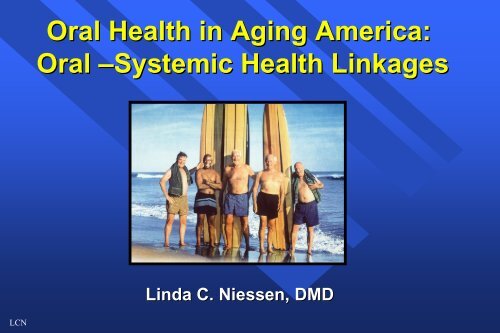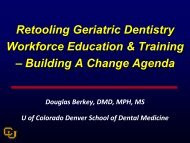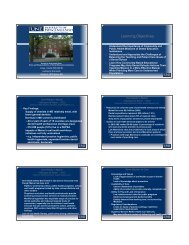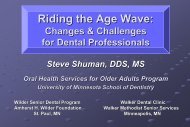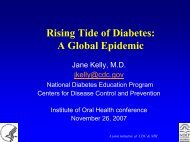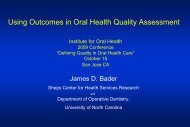Conference PPT (5 MB) - Institute for Oral Health
Conference PPT (5 MB) - Institute for Oral Health
Conference PPT (5 MB) - Institute for Oral Health
You also want an ePaper? Increase the reach of your titles
YUMPU automatically turns print PDFs into web optimized ePapers that Google loves.
<strong>Oral</strong> <strong>Health</strong> in Aging America:<br />
<strong>Oral</strong> –Systemic <strong>Health</strong> Linkages<br />
Linda C. Niessen, DMD<br />
LCN
Acknowledgements<br />
• Baylor College of Dentistry, Texas A&M HSC<br />
• DENTSPLY International
VA North Texas <strong>Health</strong> Care System
Purpose<br />
• Examine the oral health-<br />
systemic health link and the<br />
role that oral inflammation<br />
can play on systemic<br />
diseases<br />
• Discuss the most common<br />
medical conditions and<br />
medications and their<br />
effects on oral health care<br />
• Identify future oral health<br />
system needs to insure oral<br />
health in an aging America
Thesis<br />
• The mouth is connected to the<br />
rest of the body.<br />
– New research is identifying the<br />
effects of oral infection and<br />
inflammation on target organs.<br />
• Caring <strong>for</strong> older adults makes<br />
these linkages readily<br />
apparent.<br />
– Dental professionals need<br />
greater interaction with the<br />
overall health care system.<br />
• Patients are beginning to<br />
understand the relationship<br />
between oral health and<br />
systemic health.
Thesis<br />
• <strong>Oral</strong>–systemic link will re-assert<br />
the importance and value of<br />
prevention of oral diseases.<br />
– <strong>Oral</strong> diseases play a pivotal role in chronic<br />
disease management<br />
• Patients value preventive care,<br />
even when they don’t t comply.<br />
• Preventive care tells patients<br />
you value their future,<br />
regardless of how long it is!
Changing Demographics and<br />
Expectations<br />
• This is not your mother’s<br />
aging society<br />
• Baby boomers will redefine<br />
what it means to age<br />
successfully, gracefully!<br />
• It includes maintaining<br />
good health and good oral<br />
health<br />
• Older adults will seek<br />
in<strong>for</strong>mation about their<br />
health from a variety of<br />
sources
Life Expectancy of Women and Men, US<br />
20<br />
15<br />
10<br />
5<br />
0<br />
65<br />
years<br />
75<br />
years<br />
85<br />
years<br />
95<br />
years<br />
100<br />
years<br />
Men-Black 14.5 9.4 5.7 3.6 2.9<br />
Men-White 16.3 10.1 5.6 3.1 2.4<br />
Women-Black 17.4 11.2 6.5 3.6 2.7<br />
Women-White 19.2 12.1 6.7 3.5 2.7<br />
Source: Centers <strong>for</strong> Disease Control and Prevention, US National Center <strong>for</strong> <strong>Health</strong><br />
Statistics, Life Expectancy by Age, Race and Sex in the United States, 2000.
Successful Aging<br />
• Engages with life<br />
• Avoids disease<br />
• Maintains high<br />
cognitive and<br />
physical function
Successful Aging<br />
100%<br />
80%<br />
70%<br />
60%<br />
40%<br />
30%<br />
20%<br />
0%<br />
Factors<br />
Lifestyle<br />
Genetics
Genes are not your destiny
Principles of Geriatric Medicine<br />
• Age Related Changes<br />
• Disease Related Changes<br />
• Atypical Presentation of Disease<br />
• Multiple Pathology<br />
• Under Reporting of Disease Symptoms<br />
• Functional Status Assessment<br />
• Role of Interdisciplinary Team
Multiple Pathology<br />
• Heart disease<br />
• Hypertension<br />
• Arthritis<br />
• Stroke<br />
• Diabetes<br />
• Depression…<br />
– be<strong>for</strong>e you even<br />
look in the mouth<br />
Your initial medical history and medication history will<br />
take longer!
Chronic Diseases in Older Adults<br />
• Top 5 Causes of Death<br />
– Heart Disease<br />
– Cancer<br />
– Stroke<br />
– Alzheimer’s s disease<br />
– Respiratory disease<br />
• Top 5 Chronic Diseases<br />
– Arthritis<br />
– Hypertension<br />
– Heart Disease<br />
– Hearing Impairments<br />
– Cataracts<br />
What we die from!<br />
What we live with!
Heterogeneity of Elders<br />
• Active Elders 85%<br />
• Chronically Ill 10%<br />
• Nursing Home 5%<br />
Residents<br />
The differences in status often result from the number of chronic<br />
diseases and ability to maintain function, e.g. activities of daily<br />
living.
Cardiovascular Disease in the Elderly<br />
• Hypertension<br />
• Myocardial Infarct<br />
• Congestive Heart Failure<br />
• Atrial Fibrillation<br />
• Conduction System<br />
Defects<br />
• Valvular Heart Disease<br />
Does your health history <strong>for</strong>m capture these different <strong>for</strong>ms of<br />
heart disease and the medications taken to manage them
Cardiac Disease and Treatment<br />
• Organ damage due to<br />
hypertension<br />
• Muscle damage due to<br />
decreased blood supply<br />
(angina, MI)<br />
• Conduction system<br />
defect (arrythmias)<br />
• Pump malfunction (CHF)<br />
• Atrial fibrillation<br />
• Valvular disease<br />
• Diuretics, ACEI, CCB,<br />
β-blockers<br />
• NTG, CABG<br />
• Pacemaker, implanted<br />
defibrillation<br />
• Digoxin<br />
• Plavix (clopigrel), ASA<br />
• Prosthetic Valves
<strong>Oral</strong> Examination<br />
• Caries<br />
• Periodontal disease<br />
• <strong>Oral</strong> soft tissue<br />
lesion<br />
• Missing teeth
Cardiovascular Disease and Periodontal<br />
Infections<br />
• Evidence continues to mount that periodontal<br />
infections play a contributory role in the development<br />
of cardiovascular disease (remember Dr. Roizen’s<br />
video yesterday)<br />
• Are we ready to recommend and reimburse<br />
periodontal treatment in the patient with moderate-<br />
severe, localized or generalized periodontal disease<br />
as part of the management of his/her cardiovascular<br />
disease<br />
Source: R Demmer and M. Desvarieux. Periodontal<br />
infections and cardiovascular disease. JADA 137: 14s-<br />
20s, October, 2006.
Dental Implications of<br />
Cardiovascular Treatment<br />
• Physician consult<br />
– When in doubt, ask<br />
• Hypertension<br />
– Check BP at each dental visit<br />
• Medications<br />
– Xerostomia –BB, ACEI, CCB, ARB<br />
– Gingival Overgrowth-nifedipine<br />
– Lichenoid reactions<br />
– Bleeding – Plavix, Aspirin<br />
• Valvular Disease<br />
– New SBE Guidelines
CARDIAC CONDITIONS FOR WHICH PROPHYLAXIS FOR<br />
DENTAL PROCEDURES IS RECOMMENDEDFOR<br />
PREVENTION OF BACTERIAL ENDOCARDITIS*<br />
• Prosthetic cardiac valve<br />
• Previous infective endocarditis<br />
• Congenital Heart Disease (CHD)<br />
– Unrepaired cyanotic CHD, including palliative shunts and conduits<br />
– Completely repaired congenital heart defect with prosthetic material or device,<br />
whether placed by surgery or by catheter intervention, during the e first 6<br />
months after the procedure (endothelialization occurs within 6 month m<br />
of<br />
procedure)<br />
– Repaired CHD with residual defects at the site or adjacent to the e site of a<br />
prosthetic patch or prosthetic device (which inhibits endothelialization)<br />
lization)<br />
• Cardiac transplant recipients who develop cardiac valvulopathy<br />
*Except <strong>for</strong> the cardiac conditions listed above, antibiotic prophylaxis is no longer<br />
recommended <strong>for</strong> any cardiac condition or problem.<br />
Source: Current American Heart Association Guidelines<br />
Published May 8, 2007, Circulation, , Vol. 115.
Dental Procedures and<br />
Rational <strong>for</strong> Revisions<br />
• All dental procedures that involve manipulation of gingival<br />
tissue or the periapical region of the teeth or per<strong>for</strong>ation of<br />
the oral mucosa (not needed <strong>for</strong> LA through non-infected<br />
tissue, radiographs, placement of and/or adjustment of<br />
removable or orthodontic appliances, shedding of 1 o teeth)<br />
• Infective endocarditis (IE) more likely to result from frequent<br />
exposure to random bacteremias associated with daily<br />
activities<br />
• Maintenance of optimal oral health & hygiene may reduce<br />
incidence of bacteremia from daily activities and may be<br />
more important than prophylactic antibiotics <strong>for</strong> a dental<br />
procedure to reduce the risk of IE<br />
Source: Wilson, et al. Prevention of infective endocarditis: Guidelines from<br />
the American Heart Association. JADA 138:739-760, 760, June 2007.
Cerebrovascular Accident<br />
• 500,000 new cases each<br />
year<br />
• 3rd most common cause<br />
of death<br />
• Can be thrombolytic or<br />
hemorrhagic<br />
• Most common sequelae-<br />
motor loss of dominant<br />
side
Cerebrovascular Accident<br />
• Study reported a 400%<br />
increase in stroke risk<br />
associated with<br />
periodontitis but found<br />
no relationship between<br />
caries and stroke.<br />
• <strong>Oral</strong> inflammation plays<br />
a role in the mechanism<br />
of action<br />
Source: Grau AJ, Becher H, Ziegler CM et al. Periodontal disease<br />
as a risk factor <strong>for</strong> ischemic stroke. Stroke 35(2): 496-501, 2004.
Dental Implications of CVA<br />
• Transportation to office<br />
• Dominant hand function and<br />
oral self care abilities<br />
• Aphasia<br />
• Depression<br />
• Transfer to dental chair<br />
• Loss of oral motor function<br />
• Post-op op meds:<br />
– Anti-coagulants<br />
– Bleeding-need need INR data<br />
– Gingival overgrowth
•Dilantin (Anticonvulsant)<br />
•Nifedipine (Calcium<br />
Channel Blocker)<br />
•Cyclosporine<br />
(Immunosuppressive)<br />
•New BP medications<br />
• Isn’t dental care<br />
medically necessary<br />
after a CVA as part of<br />
the management
Diabetes Mellitus<br />
• >9% of population<br />
• Onset<br />
– Type I-5-10% I<br />
(Juvenile)<br />
– Type II- 90-95% 95% (Adult)<br />
• Medications<br />
– <strong>Oral</strong> hypoglycemic<br />
– Insulin<br />
• Research on diabetes<br />
and perio disease most<br />
developed
Dental Implications<br />
• Higher risk of infections<br />
– periodontal disease<br />
– oral candida<br />
• Research is showing that when<br />
diabetics have their periodontal<br />
infections treated, their insulin<br />
requirements decrease<br />
• Doesn’t t this suggest that<br />
treatment of periodontal<br />
infections is part of the<br />
management of the diabetic<br />
patient
Source: Considerations <strong>for</strong> treating the dental patient with diabetes.<br />
American Dental Association, 2003.<br />
Considerations <strong>for</strong> Dental Treatment<br />
• More frequent recall<br />
• Emphasis on soft<br />
tissue management<br />
– SRP prn<br />
– Antiobiotic treatment<br />
• AM appointments (or<br />
when insulin at peak)
Diabetes – The poster disease <strong>for</strong><br />
reconnecting reimbursement <strong>for</strong><br />
oral care with medical care<br />
• In the management of the<br />
diabetic patient, why can<br />
the diabetic patient have<br />
his:<br />
– blood glucose managed<br />
– cardiovascular disease<br />
treated<br />
– eye disease resolved<br />
– foot care evaluated<br />
– periodontal infections<br />
ignored
Osteoporosis<br />
• Loss of bone mass and<br />
architecture<br />
• Increased risk of<br />
fracture<br />
• Female to male ratio<br />
4:1<br />
• 1.5 million fractures<br />
annually
Treatment of Osteoporosis<br />
• Vitamin D<br />
• Calcium<br />
• Weight bearing<br />
exercise (not<br />
swimming)<br />
• Strength training<br />
• Fluoride (Pak et al)<br />
• Bisphosphonates<br />
– Fosamax, Aredia,<br />
Boniva
Bisphosphonate Induced<br />
Osteonecrosis of the Jaw (ONJ)<br />
Slide courtesy of Dr. Harry<br />
Gilbert, VAMC Houston<br />
Zolendronic acid (Zometa) - IV<br />
Novartis<br />
Pamidronate (Aredia) - IV<br />
Novartis<br />
Alendronate (Fosamax) - oral<br />
Merck<br />
Risendronate (Actonel) - oral<br />
Procter and Gamble<br />
Pharmaceuticals
Risk of Osteonecrosis of the Jaw <strong>for</strong><br />
Patients Taking Bisphosphonates<br />
• Risk <strong>for</strong> developing ONJ with IV bisphosphonates<br />
is ~10-12% 12% (multiple myeloma, breast CA-any CA<br />
metastatic to bone; drugs control osteoclasts).<br />
• Risk <strong>for</strong> developing ONJ with oral bisphosphonates<br />
is less than 1%.<br />
• Lower risk <strong>for</strong> ONJ in first 6 months of IV therapy;<br />
first 3 years of oral treatment.<br />
Source: Migliorati, CA, JA Casiglis, J. Epstein, PI Jacobsen, MA Siegel, SB Woo.<br />
Managing the care of patents with bisphospnhonate-associated associated osteonecrosis:<br />
An American Academy of <strong>Oral</strong> Medicine position paper. JADA 136(12):1658<br />
):1658-68, 68,<br />
2005.
Strategies <strong>for</strong> Patients on<br />
• Take a good history<br />
Bisphosphonates<br />
– <strong>Oral</strong> bisphosphonates < IV<br />
Bisphosphonates<br />
– <strong>Oral</strong> bisphosphonates < 3 yrs<br />
• Consult with patient’s s MD<br />
• Treatment Planning<br />
– In<strong>for</strong>med consent<br />
– Tooth conserving procedures<br />
(endo v. extraction)<br />
• Prevention<br />
– Good oral hygiene<br />
– Regular dental visits<br />
Slide courtesy of Dr. Richard<br />
Davis, Cleveland, VAMC<br />
Source: Robert Marx, Bisphosphonate-induced Osteonecrosis of the Jaw, 2006.
Rheumatoid Arthritis and<br />
Osteoarthritis<br />
• Inflammatory<br />
mechanism<br />
• Disabilities<br />
– How does patient get<br />
to your office<br />
– Evaluate oral hygiene<br />
self care<br />
• Medications<br />
– Pain meds
Professional <strong>Oral</strong> Care<br />
• Control biofilms with<br />
scaling and root planing<br />
based on patient’s s needs -<br />
PRN<br />
• Rein<strong>for</strong>ce daily oral self<br />
care<br />
• Will require more of the<br />
dental hygienist’s s time<br />
• Consider reimbursing <strong>for</strong><br />
time rather than CPT code<br />
– Or add co-morbities
Degenerative Joint Disease<br />
• Can lead to joint<br />
replacement<br />
• Can have total joint<br />
replaced or pins placed<br />
to repair fractures<br />
• Joint replacements<br />
require antibiotics <strong>for</strong><br />
high risk patients
ADA Guidelines on<br />
Prophylactic Antibiotics <strong>for</strong><br />
Patients With Prosthetic Joints<br />
If:<br />
<strong>Health</strong>y<br />
Risk Factors<br />
NO<br />
YES<br />
Source: Antibiotic prophylaxis <strong>for</strong> dental patients with total<br />
joint replacements. JADA, 134:895-898 July 2003.
Patients at potential increased risk<br />
of hematogenous total joint<br />
• All patients during first two years<br />
following joint replacement<br />
• Immunocompromised/immuno-<br />
suppressed patients<br />
– Inflammatory arthropathies: rheumatoid arthritis,<br />
systemic lupus erythematosus<br />
– Drug- or radiation-induced induced immunosuppression<br />
• Patients with co-morbidities
Patients at potential increased risk<br />
of hematogenous total joint<br />
• Patients with co-morbidities<br />
– Previous prosthetic joint infections<br />
– Malnourishment<br />
– Hemophilia<br />
– HIV Infection<br />
– Insulin-dependent (Type 1) diabetes<br />
– First 2 years following joint placement<br />
– Malignancy<br />
Source: Antibiotic prophylaxis <strong>for</strong> dental patients with total<br />
joint replacements. JADA, 134:895-898 July 2003.
Medication Use<br />
• OTC Medications<br />
(not perceived as<br />
medicines or<br />
serious)<br />
• Multiple<br />
prescription<br />
medications<br />
• Compliance<br />
• Interactions<br />
• Change frequently
Medications<br />
• Prescription Meds<br />
– Anti-hypertensives<br />
– Diabetic meds<br />
– Cholesterol<br />
lowering<br />
– Cardiac meds<br />
– NSAID (anti-<br />
arthritics)<br />
– Anti-depressants<br />
• OTC Meds<br />
– Antacids (sugar<br />
content)<br />
– Analgesics (ASA)<br />
– Vitamins (E and C)<br />
– Herbal<br />
Supplements<br />
» Glucosamine<br />
» Chondroitin sulfate<br />
» Co-enzyme Q<br />
Bleeding and oral dryness among concerns with multiple<br />
medication use.
Saliva: A Natural Resource
Signs of Xerostomia<br />
• Increased caries,<br />
especially root caries<br />
• Epithelial atrophy<br />
• Inflammatory fissuring<br />
• <strong>Oral</strong> candida infection
Differential Diagnosis of<br />
Alterations in Salivary Flow<br />
• Multiple medications<br />
• Head and neck<br />
radiation<br />
• Endocrine changes<br />
• Primary salivary gland<br />
pathology
Medications Causing <strong>Oral</strong> Dryness<br />
• Antidepressants<br />
• Antihistamines<br />
• Antihypertensives<br />
• Antineoplastics<br />
• Antipsychotics<br />
• Antispasmodics<br />
• Decongestants<br />
• Diuretics<br />
• Tranquilizers<br />
Medications taken on a regular basis <strong>for</strong> a<br />
long time cause more oral dryness.
Treatment Options<br />
• Hydration<br />
– Older adults often<br />
don’t t thirst<br />
– Frequent liquids<br />
– Reduce liquids<br />
containing caffeine or<br />
alcohol<br />
• Mechanical<br />
– Chewing xylitol gum
Johnson JT,et al. <strong>Oral</strong> pilocarpine in post-irradiation xerostomia in patients<br />
with head and neck cancer. New Engl J Med, 329:390, 1993<br />
Prescription Medications<br />
• Pilocarpine<br />
(Salagen®)<br />
– 5 mg. tid (not to<br />
exceed 30 mg/day)<br />
– Treat <strong>for</strong> minimum<br />
of 90 days<br />
– Contraindications:<br />
Asthma, glaucoma<br />
– Side effects:<br />
sweating<br />
• Cevimeline<br />
(Evoxac)<br />
– 30-60 mg. Tid (not<br />
to exceed 180<br />
mg/day)<br />
– Contraindications:<br />
asthma, glaucoma,<br />
severe COPD<br />
– Side effects:<br />
sweating
Salivary Substitutes<br />
• Provide palliative<br />
relief from oral<br />
dryness<br />
• Replace minerals<br />
and enzymes in<br />
saliva<br />
• Can use prn<br />
• Contraindicated-<br />
alcohol-based<br />
mouthrinses<br />
• Ingredients include:<br />
– ions: Na, Cl, Mg, F, Ca,<br />
Phosphates<br />
– flavoring: lemon, mint,<br />
neutral<br />
– lubricants/sweeteners-<br />
glycerin, sorbitol,<br />
xylitol<br />
– preservative-paraben<br />
paraben<br />
– enzymes- lactoferrins,<br />
peroxidases, etc
Risk Assessment<br />
Who is susceptible<br />
LCN
Risk Assessment<br />
There are no generic<br />
patients.
Risk Assessment<br />
<strong>Oral</strong>-systemic health<br />
research is<br />
demonstrating the<br />
importance of oral<br />
inflammation and<br />
that oral care is<br />
critical to the<br />
management of<br />
chronic diseases.
Maintaining teeth is<br />
sometimes just as<br />
difficult- but plays a<br />
key role in daily<br />
eating, speaking,<br />
smiling, swallowing.<br />
Losing teeth is<br />
psychological and<br />
physically difficult.
Conclusions<br />
• Mouth is connected to the rest<br />
of the body.<br />
• Older adults demonstrate the<br />
connection between systemic<br />
diseases and medications on<br />
oral health more readily than<br />
other populations<br />
• Presence of oral infection &<br />
inflammation can exacerbate<br />
systemic illnesses and vice<br />
versa<br />
• We need a social marketing<br />
campaign about the<br />
relationship b/w oral disease &<br />
systemic diseases
Conclusions<br />
• <strong>Oral</strong> diseases can play a<br />
pivotal role in chronic disease<br />
management.<br />
• High level of interaction<br />
between the dental care<br />
system and the medical care<br />
system is critical to healthy<br />
aging.<br />
• Linking financing &<br />
reimbursement between oral<br />
care system & medical system<br />
may improve system<br />
efficiencies and lower costs<br />
• Very vulnerable continue to<br />
have the least access to oral<br />
health care
What would you do differently<br />
as a result of this conference<br />
• Will it be to control your own aging through gene expression<br />
and reduce your stress per Dr. Roizen and Dr. Singer<br />
• Become an advocate and care <strong>for</strong> more older adults per Dr.<br />
Shuman<br />
• Examine new methods of financing & reimbursement per Dr.<br />
Jones<br />
• Educate next generation of dental and medical professionals<br />
together per Dr. Berkey<br />
• Develop novel community delivery programs per Dr.<br />
Helgeson<br />
• Let your voice be heard and insure that oral health is included<br />
in the debate on universal health coverage in the US per Dr.<br />
Olsen
“May you die very young,<br />
at a very old age.”


